If you’ve ever bought a pack of sliced bacon and found yourself with more than you can eat before the expiration date, you might be wondering whether it’s safe to refreeze sliced bacon. The good news is, yes, you can refreeze it! However, there are a few important tips to keep in mind to ensure that the bacon stays safe and delicious when you’re ready to cook it again. In this guide, we’ll walk you through the best practices for refreezing sliced bacon, including how to properly store it, how long it lasts in the freezer, and how to maintain its crispy, savory flavor when you finally pull it out for breakfast or a recipe.
Can You Refreeze Sliced Bacon?

The question of whether you can refreeze sliced bacon might seem straightforward, but it actually requires a nuanced understanding of food safety, texture, and flavor preservation. Sliced bacon, unlike many other meats, contains a relatively high fat content intertwined with lean strips, and this fat can influence how well the product withstands freezing and refreezing cycles.
Technically, yes, you can refreeze sliced bacon, but it hinges on how the bacon was handled after it was first thawed. If the bacon was thawed properly in the refrigerator and has not been left out at room temperature for extended periods, refreezing is generally safe from a microbiological standpoint. However, if the bacon was thawed using methods that expose it to warmer temperatures (like thawing on the countertop or using a microwave), refreezing is discouraged due to the increased risk of bacterial growth.
That said, from a culinary and quality perspective, refreezing bacon is a bit more complex. The process of freezing and thawing causes moisture to migrate and ice crystals to form, which can rupture cell walls in the meat, especially in delicate slices like bacon. This can affect texture and moisture retention, which impacts the bacon’s final taste and mouthfeel when cooked.
How To Refreeze Sliced Bacon?
If you find yourself with sliced bacon that was thawed but won’t be fully used, proper steps can ensure both safety and minimize quality loss when refreezing:
-
Ensure Proper Initial Thawing:
Thaw bacon in the refrigerator, ideally on a plate or tray to catch any moisture drips, and keep it below 40°F (4°C). Avoid leaving it out on the counter.
-
Use Quickly:
After thawing, try to refreeze within 1-2 days. The longer it sits, even refrigerated, the higher the chance bacteria can multiply, even slowly.
-
Wrap It Well:
Before refreezing, separate the slices if possible. Wrap the bacon tightly in plastic wrap or aluminum foil, or better yet, place the slices in a vacuum-sealed bag or freezer-grade resealable bag. Remove as much air as possible to prevent freezer burn.
-
Label the Package:
Note the date of refreezing to keep track of storage times. Bacon is best consumed within 1-2 months after refreezing for optimal quality.
-
Freeze Quickly:
Place the bacon in the coldest part of your freezer to freeze it quickly, reducing large ice crystal formation that can damage texture.
When you’re ready to use the refrozen bacon, thaw it again in the refrigerator, not at room temperature, and cook it promptly.
Quality Impact
Refreezing sliced bacon inevitably affects its quality, especially in terms of texture, flavor, and moisture content. Here’s why:
- Texture Changes: The water content in bacon freezes and forms ice crystals. When thawed, these crystals melt, and some of the moisture is lost. Refreezing and thawing again intensify this process, making the bacon slices drier and potentially crumbly. The fat in bacon can also separate or become grainy.
- Flavor Deterioration: Bacon’s rich flavor comes from its fat and curing process. As fat oxidizes over repeated freeze-thaw cycles, it can develop off-flavors or become less aromatic. This might dull the smoky or savory notes that make bacon so beloved.
- Appearance: Refrozen bacon may exhibit discoloration or slight freezer burn if not wrapped properly. Freezer burn occurs when moisture evaporates from the surface, leaving dry, grayish patches.
- Cooking Performance: Because refrozen bacon may lose some moisture, it might cook faster and become crisper or more brittle than fresh-frozen slices. This isn’t necessarily bad but can alter how you use it in recipes.
In short, while refreezing sliced bacon is safe under controlled conditions, each cycle of freezing and thawing chips away at the original quality. The key is to minimize how often it happens and store the bacon properly to retain as much flavor and texture as possible.
The ability to refreeze sliced bacon safely is largely dependent on how the bacon was initially thawed and handled. Proper refrigeration thawing and swift refreezing can make the process safe, but quality will likely diminish somewhat. The texture may become less tender, the flavor less vibrant, and the moisture content lower, leading to a less enjoyable eating experience.
For best results, plan your bacon usage to avoid multiple freeze-thaw cycles. If you must refreeze, take care to wrap it tightly and freeze it quickly to preserve as much freshness as possible. Ultimately, the convenience of refreezing sliced bacon must be balanced against the inevitable drop in quality-something to keep in mind for your next breakfast or recipe preparation!
Is It Safe To Refreeze Sliced Bacon?
When it comes to refreezing sliced bacon, the answer isn’t a simple yes or no-it hinges on how the bacon was handled after its initial thawing. Generally speaking, bacon is a perishable product that requires careful storage to prevent bacterial growth. If sliced bacon has been thawed properly in the refrigerator and has remained cold (below 40°F or 4°C), it can be safely refrozen. This is because low temperatures inhibit the growth of harmful bacteria.
However, refreezing bacon after it has been left out at room temperature for more than two hours-or longer if temperatures are warmer-poses significant food safety risks. Bacteria multiply rapidly in the "danger zone" (40°F to 140°F), and refreezing in such cases won’t kill the bacteria; it only pauses their activity until thawed again.
Moreover, refreezing can affect the quality of the bacon. The water content in the bacon forms ice crystals during freezing. When thawed, these crystals melt, sometimes causing the bacon to become dry or develop an undesirable texture. Refreezing exacerbates this process, potentially degrading taste and texture with each freeze-thaw cycle.
In summary, while refreezing sliced bacon can be safe if done correctly, it’s best to minimize the number of freeze-thaw cycles to preserve both safety and quality.
Signs That Sliced Bacon Should Not Be Refrozen
Knowing when bacon should be discarded instead of refrozen is critical for avoiding foodborne illness and poor culinary outcomes. Here are the key signs indicating that sliced bacon should not be refrozen:
- Off or Sour Smell: Bacon with a pungent, sour, or rancid odor is a clear red flag. Fresh bacon typically smells smoky, salty, or slightly sweet. Any foul odor indicates spoilage.
- Slimy or Sticky Texture: If the bacon feels sticky, tacky, or slimy to the touch, it means bacteria or mold growth may have started, making it unsafe to eat or refreeze.
- Discoloration: Fresh bacon usually has a pinkish-red color with white fat streaks. If the slices have turned grayish, greenish, or developed dark spots, it signals spoilage or oxidation.
- Extended Time at Room Temperature: Bacon left out unrefrigerated for over two hours (or one hour if it’s hot outside) should be considered unsafe to refreeze or consume.
- Previously Refrozen Multiple Times: If bacon has been thawed and refrozen more than once, it’s best to avoid refreezing again, as repeated cycles increase bacterial risk and quality degradation.
If you spot any of these signs, it’s safer and more prudent to discard the bacon rather than risk food poisoning.
Common Refreezing Mistakes
Many people unintentionally jeopardize food safety and quality through common mistakes when refreezing sliced bacon:
- Refreezing at Room Temperature: Leaving bacon out on the counter to thaw and then refreezing it is a major mistake. This allows bacteria to flourish during the thawing period.
- Refreezing Thawed Bacon Without Checking Its Condition: Not inspecting the bacon for spoilage signs before refreezing can lead to preserving unsafe food.
- Storing Bacon in Improper Packaging: Refreezing bacon in containers that are not airtight or moisture-proof causes freezer burn, which damages taste and texture.
- Ignoring Thawing Method: Using rapid thawing methods like microwaving or warm water to thaw bacon before refreezing can create uneven temperature zones where bacteria can multiply.
- Freezing Bacon That Has Been Cooked and Left Out Too Long: Even cooked bacon can become unsafe if left out for long periods before refreezing.
Avoiding these pitfalls requires attention to detail and good food hygiene habits.
Tips And Tricks
To safely refreeze sliced bacon and maintain its best possible quality, keep the following tips in mind:
- Thaw Only in the Refrigerator: Always thaw bacon slowly in the fridge at temperatures below 40°F (4°C). This minimizes bacterial growth.
- Freeze Quickly After Purchase: If you don’t plan to use bacon within a week, freeze it promptly to lock in freshness.
- Portion Before Freezing: Divide bacon into meal-sized portions before freezing, so you only thaw what you need, reducing waste.
- Use Airtight Packaging: Wrap bacon tightly in plastic wrap or aluminum foil, then place it in a freezer-safe ziplock bag or vacuum-sealed pouch to prevent freezer burn.
- Label with Dates: Keep track of when the bacon was frozen to use it within recommended timeframes (ideally within 1-2 months for best quality).
- Don’t Refreeze After Cooking: If you cook bacon, try to consume it promptly or refrigerate leftovers instead of refreezing.
- Trust Your Senses: When in doubt, rely on your nose and eyes to judge whether bacon is still good.
Conclusion
Refreezing sliced bacon is a nuanced practice that demands careful attention to food safety principles. While it can be safe to refreeze bacon that has been properly thawed and stored, it’s essential to recognize the warning signs of spoilage and avoid common mistakes that can lead to foodborne illness. By following sensible thawing and freezing methods, using proper packaging, and practicing good hygiene, you can maximize both the safety and quality of your bacon. Ultimately, when handling perishable foods like bacon, it’s better to err on the side of caution-because no meal is worth risking your health.


